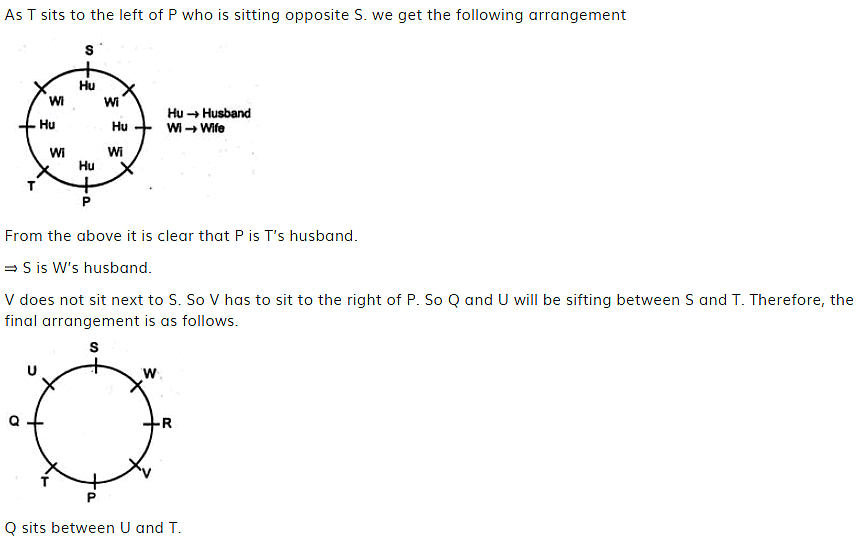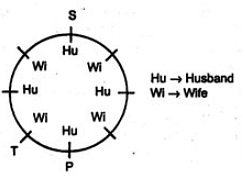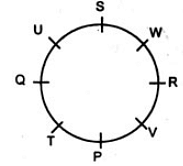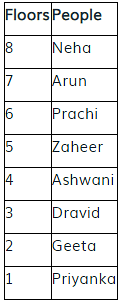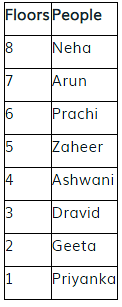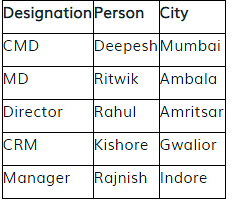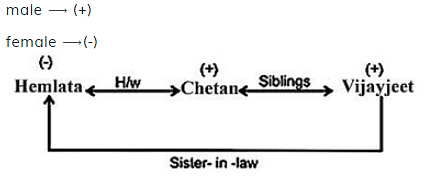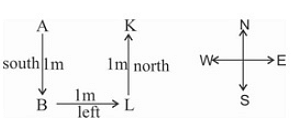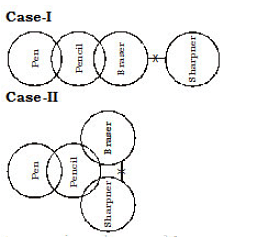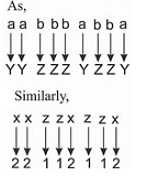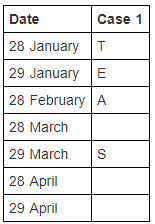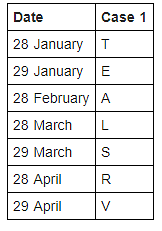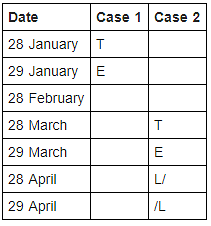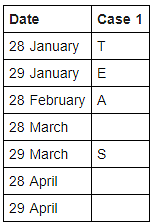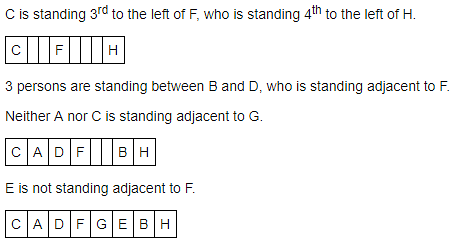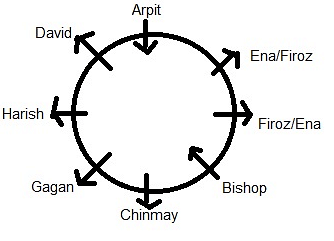EPFO Assistant Prelims Mock Test - 2 - Bank Exams MCQ
30 Questions MCQ Test Mock Test Series for EPFO Assistant 2025 - EPFO Assistant Prelims Mock Test - 2
DIRECTIONS: These questions are based on the following data.
Four couples sit around a circular table in a party. Every husband sits to the right of his wife. P, Q, R and S are husbands and T, U, V and W are wives. Q - U and R - V are two married couples. S does not sit next to V. T sits to the left of P, who sits opposite S.
Q. Q sits between _______.
Four couples sit around a circular table in a party. Every husband sits to the right of his wife. P, Q, R and S are husbands and T, U, V and W are wives. Q - U and R - V are two married couples. S does not sit next to V. T sits to the left of P, who sits opposite S.
DIRECTIONS: These questions are based on the following data.
Four couples sit around a circular table in a party. Every husband sits to the right of his wife. P, Q, R and S are husbands and T, U, V and W are wives. Q - U and R - V are two married couples. S does not sit next to V. T sits to the left of P, who sits opposite S.
Q. If P interchanges his place with the person who sits opposite to R disregarding the condition that husband and wife sit together, then who sits to the right of U?
Four couples sit around a circular table in a party. Every husband sits to the right of his wife. P, Q, R and S are husbands and T, U, V and W are wives. Q - U and R - V are two married couples. S does not sit next to V. T sits to the left of P, who sits opposite S.
| 1 Crore+ students have signed up on EduRev. Have you? Download the App |
DIRECTIONS: Study the information carefully and answer the question given below.
There are eight persons Ashwani, Geeta, Zaheer, Prachi, Arun, Dravid, Neha and Priyanka living on an eight-floor building (Ground floor is numbered 1 and topmost floor is number 8.) but not necessary in the same order.
The total number of persons living between Ashwani and Geeta is same as the total number of persons living between Ashwani and Prachi. There is one person living between Neha and Prachi who lives just below Arun. Zaheer lives on an odd number floor below 6th floor. There are two persons live between Zaheer and Neha. Dravid lives on one of the odd number floors but not on the bottom floor. Geeta lives on the floor below Ashwani.
Q. On which of the following floor Prachi lives?
There are eight persons Ashwani, Geeta, Zaheer, Prachi, Arun, Dravid, Neha and Priyanka living on an eight-floor building (Ground floor is numbered 1 and topmost floor is number 8.) but not necessary in the same order.
The total number of persons living between Ashwani and Geeta is same as the total number of persons living between Ashwani and Prachi. There is one person living between Neha and Prachi who lives just below Arun. Zaheer lives on an odd number floor below 6th floor. There are two persons live between Zaheer and Neha. Dravid lives on one of the odd number floors but not on the bottom floor. Geeta lives on the floor below Ashwani.
DIRECTIONS: Study the information carefully and answer the question given below.
There are eight persons Ashwani, Geeta, Zaheer, Prachi, Arun, Dravid, Neha and Priyanka living on an eight-floor building (Ground floor is numbered 1 and topmost floor is number 8.) but not necessary in the same order.
The total number of persons living between Ashwani and Geeta is same as the total number of persons living between Ashwani and Prachi. There is one person living between Neha and Prachi who lives just below Arun. Zaheer lives on an odd number floor below 6th floor. There are two persons live between Zaheer and Neha. Dravid lives on one of the odd number floors but not on the bottom floor. Geeta lives on the floor below Ashwani.
Q. Four of the following five are alike in a certain way based on their arrangement find the one which does not belong to that group?
DIRECTIONS: Study the information carefully and answer the question given below.
There are eight persons Ashwani, Geeta, Zaheer, Prachi, Arun, Dravid, Neha and Priyanka living on an eight-floor building (Ground floor is numbered 1 and topmost floor is number 8.) but not necessary in the same order.
The total number of persons living between Ashwani and Geeta is same as the total number of persons living between Ashwani and Prachi. There is one person living between Neha and Prachi who lives just below Arun. Zaheer lives on an odd number floor below 6th floor. There are two persons live between Zaheer and Neha. Dravid lives on one of the odd number floors but not on the bottom floor. Geeta lives on the floor below Ashwani.
Q.On which of the following floor priyanka lives?
DIRECTIONS: These questions are based on the following data.
Five people Rahul, Kishore, Deepesh, Ritwik, and Rajnish were in different positions in decreasing order of CMD, MD, Director, Chief Regional Manager and Manager. They were posted in different places among Indore, Mumbai, Ambala, Amritsar and Gwalior.
- Director was posted in Amritsar
- Rahul was ranked higher than Kishore who was posted in Gwalior
- Deepesh was CMD
- Person from Indore was Ranked least and Ritwik was posted in Ambala.
Q. Which Designation felt between the Ritwik’s Designation and the one Which belonged to Gwalior?
DIRECTIONS: These questions are based on the following information.
Seven persons - Dinesh, Ganesh, Mahesh, Naresh, Rajesh, Suresh and Veeresh are seated in a row, not necessarily in the same order, facing north. We know the following additional information about them.
(i) Ganesh is exactly in between Suresh and Dinesh
(ii) The number of persons to the right of Rajesh is same as the number of persons to the left of Veeresh.
(iii) Dinesh is to the right of Rajesh.
(iv) Veeresh is second from the extreme right.
(v) Dinesh is two places away to the left of Naresh.
(vi) Rajesh is to the left of Mahesh.
Q. Who is third from the extreme left?
DIRECTIONS: These questions are based on the following information.
Seven persons - Dinesh, Ganesh, Mahesh, Naresh, Rajesh, Suresh and Veeresh are seated in a row, not necessarily in the same order, facing north. We know the following additional information about them.
(i) Ganesh is exactly in between Suresh and Dinesh
(ii) The number of persons to the right of Rajesh is same as the number of persons to the left of Veeresh.
(iii) Dinesh is to the right of Rajesh.
(iv) Veeresh is second from the extreme right.
(v) Dinesh is two places away to the left of Naresh.
(vi) Rajesh is to the left of Mahesh.
Q. Who is at the extreme right?
DIRECTIONS: These questions are based on the following information.
Seven persons - Dinesh, Ganesh, Mahesh, Naresh, Rajesh, Suresh and Veeresh are seated in a row, not necessarily in the same order, facing north. We know the following additional information about them.
(i) Ganesh is exactly in between Suresh and Dinesh
(ii) The number of persons to the right of Rajesh is same as the number of persons to the left of Veeresh.
(iii) Dinesh is to the right of Rajesh.
(iv) Veeresh is second from the extreme right.
(v) Dinesh is two places away to the left of Naresh.
(vi) Rajesh is to the left of Mahesh.
Q. Who is at the middle of the row?
DIRECTIONS: Answer the questions based on the following information:
Hemlata, Chetan and Vijayjeet are related to each other.
I. Among the three, one is Hemlata’s legal spouse, another is Chetan’s sibling and the third is Vijayjeet’s sister- in-law.
II. Hemlata’s legal spouse and Chetan’s sibling are of the same sex.
(Assume: There are no gay marriages.)
Q. Who is the Chetan’s sibling?
DIRECTIONS: The following questions are based on the following three-digit numbers given below:
492 567 749 658 943
Q. If all the digits of each of the numbers are arranged in ascending order within the number, how many numbers thus formed will be divisible by three?
DIRECTIONS: The following questions are based on the following three-digit numbers given below:
492 567 749 658 943
Q. If the positions of the first and the third digit of each of the numbers are interchanged, what will be the product of the second and the third digit of the second highest number thus formed?
DIRECTIONS: Read the following information carefully and answer the question given below it:
(A) D α T means T is to the right of D at a distance of one metre.
(B) D β T means T is to the North of D at a distance of one metre.
(C) D λ T means T is to the left of D at a distance of one metre.
(D) D η T means T is to the South of D at a distance of one metre.
(E) In each of the following questions all persons face South.
Q. If A η B λ L β K, then K is in which direction with respect to A?
DIRECTIONS: In the question, relationship between different elements is shown in the Statements. These Statements are followed by two Conclusions.Read the conclusions carefully and answer the question.
Statements:
Z > P, P < M, M < J
Conclusions:
I. P < J
II. J < Z
DIRECTIONS: In the question, relationship between different elements is shown in the Statements. These Statements are followed by two Conclusions.Read the conclusions based on the given statement and give answer.
Statements:
N = Z, C ≥ G, G ≥ N, N ≥ R, J ≥ C
Conclusions:
I. G ≥ Z
II. C ≥ R
DIRECTIONS: In these questions, two/three statements followed by two conclusions numbered I and II have been given. You have to take the given statements to be true even if they seem to be at variance from the commonly known facts and then decide which of the given conclusions logically follows from the given statements disregarding commonly known facts. Give answer:
Statements:
All cities are town.
All towns are village.
Some villages are states.
Conclusions:
I. At least some states are cities.
II. All villages are town.
DIRECTIONS: In these questions, two/three statements followed by two conclusions numbered I and II have been given. You have to take the given statements to be true even if they seem to be at variance from the commonly known facts and then decide which of the given conclusions logically follows from the given statements disregarding commonly known facts. Give answer:
Statements:
Some pens are pencils.
Some pencils are eraser.
No eraser is a sharpener.
Conclusions:
I. No sharpener is pencil.
II. At least some pen are sharpener.
Which number in the choices (a), (b), (c) and (d) makes the best comparisons?
Aabbbabba : YYZZZYZZY :: XXZZXZZX: ?
Directions : Seven persons A, E, L, R, S, T and V have appointments for salt therapy on either 28th or 29th of January, February, March and April of 2019. No two persons have appointments on the same day.
A has the appointment before S but not immediately. S does not have the appointment in April. T and E have an appointment in the same month but before L where T's appointment is before E. One person has an appointment between R and L. R does not have an appointment in March.
Q. How many persons have appointments in between E and A?
Directions : Seven persons A, E, L, R, S, T and V have appointments for salt therapy on either 28th or 29th of January, February, March and April of 2019. No two persons have appointments on the same day.
A has the appointment before S but not immediately. S does not have the appointment in April. T and E have an appointment in the same month but before L where T's appointment is before E. One person has an appointment between R and L. R does not have an appointment in March.
Q. If L and R exchange their appointment dates, then what will be the five-letter word formed by the consecutive names of the persons starting from 28th January to 29th March?
Directions : A family consists of six members such that three of them are males. K is the sister-in-law of C. T is the son of M. T does not have brothers. E is the sister-in-law of H. E does not have any siblings. K has two children. Either both or none of the parents of a person are alive.
Q. How is H related to C?
Directions : A family consists of six members such that three of them are males. K is the sister-in-law of C. T is the son of M. T does not have brothers. E is the sister-in-law of H. E does not have any siblings. K has two children. Either both or none of the parents of a person are alive.
Q. How is K related to H?
Directions : In a certain code language, some statements are coded as:
- "wild forest rain plant" is coded as "&& @@ ** ##"
- "plant tree bird wild" is coded as "@@ && !! >>"
- "wild tree bird forest" is coded as "!! @@ >> ##"
- "bird plant tree rain" is coded as "** >> && !!"
On the basis of the above codes, answer the following questions:
Q. What is the code for "tree"?
Directions : In a certain code language, some statements are coded as:
- "wild forest rain plant" is coded as "&& @@ ** ##"
- "plant tree bird wild" is coded as "@@ && !! >>"
- "wild tree bird forest" is coded as "!! @@ >> ##"
- "bird plant tree rain" is coded as "** >> && !!"
On the basis of the above codes, answer the following questions:
Q. What is the code for "rain forest"?
8 persons A, B, C, D, E, F, G and H are standing in a row facing north. C is standing 3rd to the left of F, who is standing 4th to the left of H. 3 persons are standing between B and D, who is standing adjacent to F. Neither A nor C is standing adjacent to G. E is not standing adjacent to F. How many persons are standing between E and A?
In the following question assuming the given statements to be true, find which of the conclusion among given three conclusions is /are definitely true and then give answers accordingly.
Statements:
N = C = B > G > A, B < H < M
Conclusions:
I. N > A
II. A < C
III. M < G
In the following question, select the odd letters from the given alternatives.
In each of the questions below arc given four statements followed by three conclusions numbered I, II and III. You have to take the given statements to be true even if they seem to be at variance from commonly known facts.
Read all the conclusions and then decide which of the given conclusions logically follows from the given statements disregarding commonly known facts.
Statements:
All beds are pins.
All pins are vadas.
All vadas are cats.
No cat is a rope.
Conclusions:
I. All cats are pins.
II. Some beds are ropes.
III. No bed is a rope.
In each question below are three statements followed by three conclusions numbered I, II and III. You have to take the three given statements to be true even if they seem to be at variance from commonly known facts and then decide which of the given conclusions logically follows from the three given statements disregarding commonly known facts.
Statements:
Some keys are carns.
Some carns are blocks.
Some blocks are parks.
Conclusions:
I. Some parks are carns.
II. Some blocks are keys.
III. Some parks are keys.
Directions : Study the following information and answer the questions that follow.
Eight directors of a particular company are sitting in a conference around a circular table. They are Arpit, Bishop, Chinmay, David, Ena, Firoz, Gagan and Harish. Some are facing the centre, and some are facing outside the centre. Arpit and Bishop are making notes on the conference and therefore are facing towards the centre while the other six people are facing away from the centre.
Arpit is sitting second to the right of Harish and Bishop is sitting third to the left of Arpit. David sits second to the right of Gagan. Gagan is an immediate neighbour of neither Bishop nor Arpit. Ena and Firoz are immediate neighbours and are facing away from the centre.
Q. What is the position of Chinmay with respect to David?


